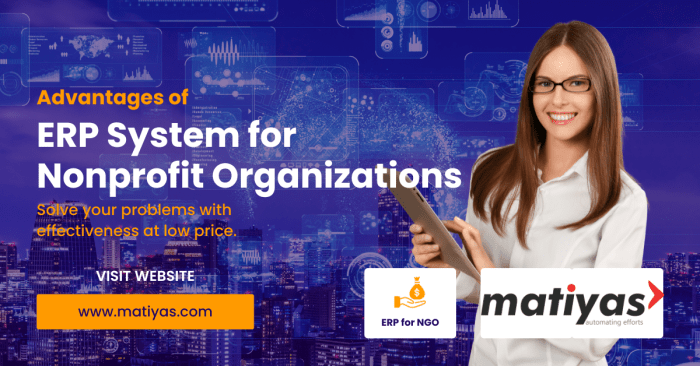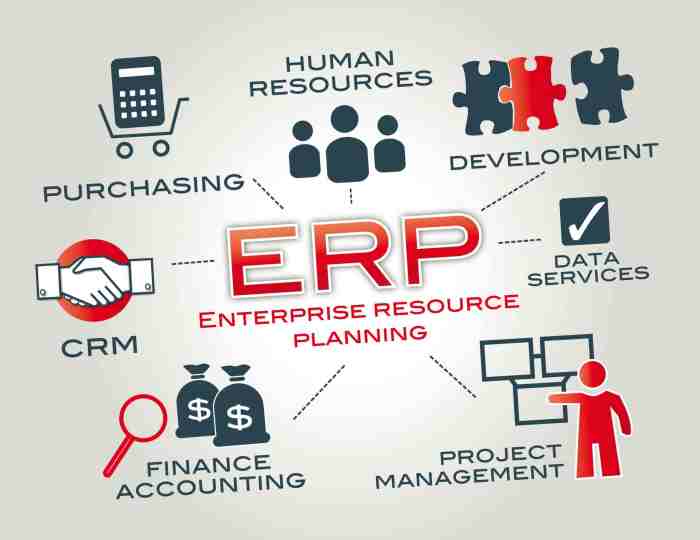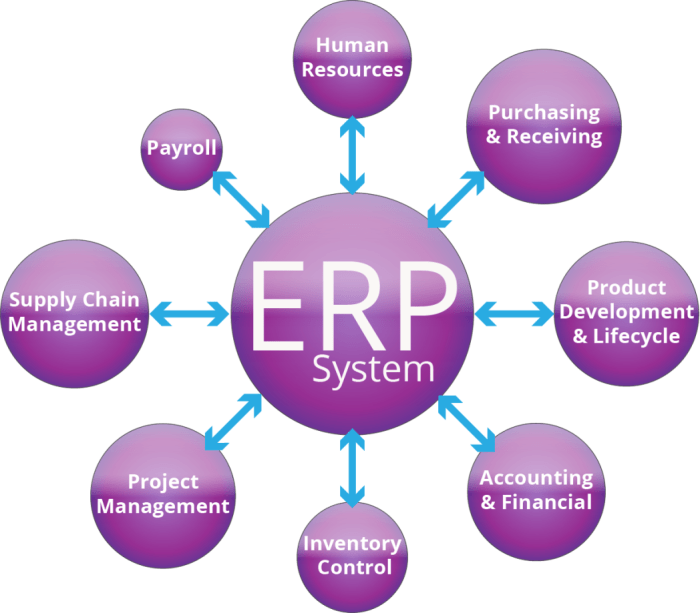ERP for non-profit organizations is a game-changer, transforming how these vital entities operate and achieve their missions. While dedicated to making a difference, non-profits often face challenges in managing their operations, from donor data and program tracking to financial reporting. ERP systems, designed specifically for the unique needs of non-profits, offer a solution by streamlining processes, improving efficiency, and maximizing impact.
Imagine a world where donor data is centralized and accessible, program outcomes are tracked with ease, and financial reporting is automated, freeing up valuable time for non-profit staff to focus on their core mission. This is the reality that ERP systems bring to the non-profit sector. By providing a unified platform for managing all aspects of operations, ERP systems empower non-profits to operate more effectively, increase transparency, and ultimately, make a greater difference in the world.
The Need for ERP in Non-Profit Organizations

Non-profit organizations play a crucial role in society, addressing critical social issues and providing essential services. However, managing their operations can be complex, often involving limited resources and a focus on mission delivery. This complexity can lead to inefficiencies, hindering their ability to maximize impact. An Enterprise Resource Planning (ERP) system can be a powerful tool for non-profits to overcome these challenges and achieve greater effectiveness.
Streamlining Operations and Improving Efficiency
ERP systems are designed to integrate and automate various aspects of an organization’s operations, creating a unified platform for managing data and processes. This integration can significantly improve efficiency by eliminating redundancies, reducing manual tasks, and streamlining workflows. For non-profits, this translates to better resource allocation, improved program delivery, and a more effective use of donor funds.
Challenges Faced by Non-Profit Organizations
Non-profit organizations face unique challenges that make ERP systems particularly valuable. These challenges include:
- Managing Donor Data: Non-profits rely heavily on donations, and effectively managing donor data is critical. This includes tracking donations, maintaining contact information, and segmenting donors for targeted communication. ERP systems provide a centralized database for donor management, enabling efficient tracking and analysis of donor relationships.
- Tracking Program Outcomes: Non-profits are often measured by the impact of their programs. ERP systems can help track program outcomes by integrating data from various sources, such as program applications, participant information, and service delivery records. This data can be used to assess program effectiveness, identify areas for improvement, and demonstrate the value of the organization’s work to stakeholders.
- Financial Reporting: Accurate and timely financial reporting is essential for non-profits to maintain transparency and accountability. ERP systems can automate financial processes, such as budgeting, expense tracking, and revenue recognition. This simplifies financial reporting, reduces the risk of errors, and provides a comprehensive view of the organization’s financial health.
Key Features of ERP for Non-Profits
An ERP system designed for non-profits should provide specific features to manage core operations efficiently and effectively. These features go beyond the standard financial and accounting functions and focus on areas crucial to non-profit success.
Donor Management
Managing donor relationships is essential for non-profits. A dedicated donor management module within an ERP system allows for:
- Centralized database: Storing comprehensive donor information, including contact details, donation history, communication preferences, and volunteer activities.
- Automated communication: Sending personalized thank-you notes, newsletters, and campaign updates to nurture relationships.
- Segmentation and targeting: Grouping donors based on demographics, giving patterns, and interests for tailored outreach.
- Gift processing: Efficiently tracking and managing donations, including online payments, recurring contributions, and pledges.
- Reporting and analysis: Generating reports on donor engagement, retention rates, and revenue trends.
Grant Management
Non-profits often rely on grants for funding. An ERP system should offer tools for effective grant management:
- Grant tracking: Maintaining a centralized repository of grant information, including deadlines, reporting requirements, and funding amounts.
- Budgeting and forecasting: Allocating grant funds to specific projects and tracking expenses against budgets.
- Reporting and compliance: Generating reports for grantors, ensuring compliance with funding guidelines and reporting requirements.
- Collaboration and communication: Facilitating communication and collaboration among staff involved in grant activities.
Program Tracking
Non-profits implement programs to achieve their mission. An ERP system can help track program performance and impact:
- Program planning and budgeting: Defining program objectives, setting budgets, and allocating resources.
- Participant management: Tracking participant demographics, engagement levels, and outcomes.
- Data collection and analysis: Collecting data on program activities and outcomes to measure impact.
- Reporting and evaluation: Generating reports on program performance, demonstrating impact to stakeholders.
Financial Reporting
Financial transparency is paramount for non-profits. An ERP system should provide comprehensive financial reporting capabilities:
- General ledger: Maintaining a complete record of financial transactions.
- Budgeting and forecasting: Creating budgets, tracking expenses, and projecting future financial performance.
- Financial statements: Generating balance sheets, income statements, and statements of cash flows.
- Auditing and compliance: Supporting audit processes and ensuring compliance with accounting standards.
- Donor reporting: Providing donors with clear and concise financial reports.
Best Practices for Selecting an ERP System
Choosing the right ERP system is crucial for non-profit success. Here are some best practices to consider:
- Define specific needs: Clearly identify the organization’s key requirements and challenges.
- Evaluate vendor reputation: Choose a vendor with a proven track record of serving non-profits.
- Consider scalability: Select a system that can grow with the organization’s needs.
- Seek user-friendly interface: Ensure the system is intuitive and easy for staff to use.
- Obtain demos and trials: Test drive the system before making a decision.
- Assess implementation costs: Factor in implementation costs, training, and ongoing support.
- Check for integration: Ensure the system integrates with existing software applications.
- Obtain references: Talk to other non-profits that use the system to gather insights.
Benefits of Implementing ERP: ERP For Non-profit Organizations
Implementing an ERP system for non-profit organizations brings a multitude of benefits, enhancing their operational efficiency, data management, transparency, and accountability. These advantages translate into improved service delivery, resource optimization, and ultimately, a greater impact on the mission of the organization.
Improved Operational Efficiency, ERP for non-profit organizations
An ERP system streamlines various organizational processes, eliminating redundancies and improving overall efficiency. It integrates different departments and functions, enabling seamless data flow and reducing manual tasks. This allows staff to focus on core mission-critical activities, resulting in a more productive and effective workforce.
- Automated workflows: ERP systems automate repetitive tasks such as data entry, invoice processing, and payroll, freeing up staff time for more strategic initiatives.
- Centralized data access: All departments can access and share information in real-time, eliminating data silos and improving collaboration.
- Streamlined reporting: ERP systems provide comprehensive reporting capabilities, enabling better decision-making based on real-time data insights.
Enhanced Data Management
ERP systems provide a centralized platform for managing all organizational data, ensuring consistency, accuracy, and accessibility. This improves data integrity, reduces errors, and facilitates informed decision-making.
- Single source of truth: ERP systems eliminate data duplication and inconsistencies, providing a single, reliable source of truth for all organizational information.
- Improved data visibility: With centralized data storage, stakeholders can easily access relevant information, enhancing transparency and accountability.
- Data-driven decision-making: ERP systems provide comprehensive reports and analytics, enabling organizations to make informed decisions based on real-time data insights.
Increased Transparency and Accountability
ERP systems enhance transparency and accountability by providing a clear audit trail of all organizational activities. This helps non-profits demonstrate their effectiveness and build trust with donors and stakeholders.
- Real-time tracking of funds: ERP systems track donations, expenses, and program outcomes, providing donors with clear visibility into how their contributions are being used.
- Compliance reporting: ERP systems can automate compliance reporting, ensuring organizations meet regulatory requirements and maintain ethical standards.
- Improved donor engagement: By providing transparency and accountability, ERP systems help non-profits build stronger relationships with donors and increase their trust.
Real-World Examples
Numerous non-profit organizations have successfully implemented ERP systems, reaping significant benefits. For instance, the American Red Cross implemented an ERP system to streamline its operations, improve donor management, and enhance disaster response capabilities. The system helped the organization achieve greater efficiency, transparency, and accountability, enabling them to better serve their mission.
Similarly, the United Way of America implemented an ERP system to improve its financial management, program tracking, and donor communication. The system helped the organization gain a comprehensive view of its operations, streamline reporting, and improve its overall effectiveness.
Implementation and Integration

Implementing an ERP system in a non-profit organization requires careful planning and execution to ensure a smooth transition and maximize benefits. This section will delve into the steps involved in implementing an ERP system, providing a roadmap for successful implementation, and sharing best practices for integrating the ERP system with existing systems and workflows.
Planning and Preparation
Thorough planning is crucial for a successful ERP implementation. This involves defining project scope, establishing clear objectives, and identifying key stakeholders.
- Define Project Scope: Clearly define the scope of the ERP implementation project, outlining the specific modules and functionalities to be included. This ensures a focused and manageable project.
- Establish Objectives: Set clear and measurable objectives for the ERP implementation, such as improved efficiency, enhanced data accuracy, or streamlined reporting. This provides a framework for success and allows for effective progress tracking.
- Identify Key Stakeholders: Identify and engage key stakeholders from different departments within the organization. This ensures that all relevant perspectives are considered and that buy-in is secured.
Training and User Adoption
Effective training is essential for user adoption and successful ERP implementation.
- Develop Comprehensive Training Materials: Create comprehensive training materials, including manuals, online tutorials, and interactive workshops, to familiarize users with the new system.
- Provide Hands-on Training: Offer hands-on training sessions where users can practice using the ERP system in a simulated environment.
- Offer Ongoing Support: Provide ongoing support to users through help desks, FAQs, and dedicated support teams to address any questions or issues that arise.
Data Migration
Migrating data from existing systems to the new ERP system is a critical step.
- Data Cleansing and Validation: Cleanse and validate existing data to ensure accuracy and consistency before migrating it to the ERP system.
- Develop Data Migration Plan: Create a detailed data migration plan outlining the process, timelines, and responsibilities for each step.
- Test Data Migration: Thoroughly test the data migration process to ensure that all data is migrated accurately and without errors.
Testing and Go-Live
Thorough testing is essential to ensure the ERP system functions as intended.
- System Integration Testing: Test the integration of the ERP system with existing systems and workflows to ensure seamless data flow and communication.
- User Acceptance Testing (UAT): Conduct UAT with key users to ensure that the system meets their needs and expectations.
- Pilot Launch: Consider a pilot launch with a small group of users to identify and address any potential issues before a full-scale rollout.
Integration with Existing Systems
Integrating the ERP system with existing systems is crucial for a seamless and efficient workflow.
- Identify Integration Points: Identify all existing systems that need to be integrated with the ERP system, such as accounting software, CRM, or donor management systems.
- Choose Integration Method: Select an appropriate integration method, such as API integration, data synchronization, or middleware, based on the specific requirements and capabilities of the systems involved.
- Test Integration: Thoroughly test the integration to ensure that data flows accurately and efficiently between the systems.
Ongoing Management and Support
Implementing an ERP system is just the first step in a long-term journey. Ongoing management and support are crucial to ensure the system continues to meet the needs of your organization and delivers maximum value. After the initial implementation, your ERP system requires ongoing attention to keep it running smoothly, secure, and aligned with your evolving needs. This includes regular maintenance, updates, training, and support.
Data Maintenance
Data is the lifeblood of any ERP system. Maintaining the accuracy and integrity of your data is essential for making informed decisions, ensuring compliance, and maximizing the benefits of your ERP investment.
- Regular data backups are essential to protect your data from accidental loss or corruption.
- Establish clear data entry and validation procedures to prevent errors and inconsistencies.
- Conduct periodic data audits to identify and correct any inaccuracies.
System Updates
ERP vendors regularly release updates and patches to improve performance, security, and functionality. Keeping your system up-to-date is crucial to ensure it remains secure and compatible with other systems.
- Regularly check for available updates and apply them promptly.
- Develop a testing plan to ensure updates do not disrupt your operations.
- Work closely with your ERP vendor to understand the impact of updates and plan for their implementation.
User Training
Effective ERP implementation requires user adoption. Ongoing training helps ensure that users understand how to use the system effectively and efficiently.
- Provide regular training sessions to introduce new features and address user queries.
- Offer online resources, such as user manuals and tutorials, to supplement training.
- Encourage users to share their experiences and best practices to create a supportive learning environment.
Technical Support
Technical support is crucial for resolving any issues that may arise with your ERP system. Having access to reliable technical support can minimize downtime and ensure the smooth operation of your system.
- Choose a reputable ERP vendor with a strong technical support team.
- Consider a support contract that provides 24/7 access to technical assistance.
- Establish clear communication channels with your technical support provider to ensure prompt issue resolution.
Case Studies and Success Stories

The best way to understand the real-world impact of ERP systems is to see them in action. Many non-profit organizations have successfully implemented ERP systems, transforming their operations and achieving significant positive outcomes. Let’s explore some real-world examples.
Case Study: The American Red Cross
The American Red Cross, a humanitarian organization, faced numerous challenges with its legacy systems. Data was siloed across multiple departments, making it difficult to track resources, manage donations, and allocate funds effectively. The organization decided to implement an ERP system to address these issues. The Red Cross chose Salesforce Nonprofit Cloud, a cloud-based ERP solution specifically designed for non-profits. The implementation process involved a thorough assessment of existing systems, data migration, and extensive user training.
The new ERP system enabled the Red Cross to:
- Consolidate data from various departments into a single, unified platform, providing a real-time view of operations.
- Streamline donation processing, track donor engagement, and personalize communications, leading to increased donor retention.
- Improve resource allocation and management, ensuring that funds were used efficiently and effectively to support disaster relief efforts.
The Red Cross reported significant improvements in efficiency, transparency, and impact after implementing Salesforce Nonprofit Cloud. The organization could better manage its resources, engage with donors more effectively, and ultimately achieve its mission of providing humanitarian assistance.
Case Study: The World Wildlife Fund
The World Wildlife Fund (WWF), a global conservation organization, needed to improve its financial management and reporting processes. The organization’s previous systems were fragmented and manual, making it challenging to track expenses, generate accurate financial reports, and comply with regulatory requirements.WWF implemented a comprehensive ERP system from Oracle, integrating financial management, procurement, and human resources modules. The new system enabled the organization to:
- Automate financial processes, reducing manual effort and improving accuracy.
- Gain real-time visibility into financial performance, allowing for better decision-making.
- Streamline procurement processes, ensuring compliance with ethical sourcing guidelines.
- Improve human resource management, including payroll, benefits, and employee performance tracking.
The implementation of the Oracle ERP system enabled WWF to achieve greater financial transparency, efficiency, and compliance. The organization could better manage its resources, track its impact on conservation efforts, and report its activities to donors and stakeholders with confidence.
Case Study: The United Way
The United Way, a network of non-profit organizations, faced challenges in managing its diverse programs and services. The organization needed a system to track program performance, manage grants, and collaborate effectively with partner agencies.The United Way implemented a cloud-based ERP solution from Microsoft Dynamics 365 Nonprofit. The new system enabled the organization to:
- Track program performance metrics and measure the impact of its initiatives.
- Manage grant applications and awards, ensuring efficient allocation of funds.
- Facilitate collaboration among partner agencies, streamlining communication and data sharing.
By implementing Microsoft Dynamics 365 Nonprofit, the United Way achieved greater program efficiency, transparency, and accountability. The organization could better track its impact, manage its resources effectively, and collaborate more effectively with its partner agencies.
Implementing an ERP system is a strategic investment for non-profits, one that promises to unlock significant benefits. From enhanced operational efficiency and improved data management to increased transparency and accountability, ERP systems equip non-profits with the tools they need to achieve their goals and make a lasting impact. As we’ve explored, careful planning, thoughtful selection, and ongoing management are key to a successful ERP implementation.
By embracing this powerful technology, non-profits can navigate the challenges of the modern world and continue to make a difference in the lives of those they serve.
FAQ Summary
What are the common challenges faced by non-profit organizations?
Non-profits often struggle with managing donor data, tracking program outcomes, ensuring financial transparency, and coordinating with volunteers and staff. These challenges can hinder their ability to operate efficiently and achieve their goals.
How can ERP systems help non-profits overcome these challenges?
ERP systems provide a centralized platform for managing donor data, tracking program outcomes, automating financial reporting, and streamlining communication. This allows non-profits to operate more efficiently, improve accountability, and focus on their mission.
What are the key features to look for in an ERP system for non-profits?
Essential features include donor management, grant management, program tracking, financial reporting, and integration with existing systems. The specific features will vary depending on the needs of the organization.
What are some of the benefits of implementing an ERP system for a non-profit?
Benefits include improved operational efficiency, enhanced data management, increased transparency and accountability, better decision-making, and ultimately, a greater impact on the organization’s mission.